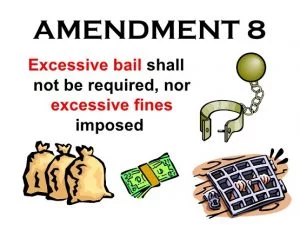Prohibits Excessive Bail and Cruel and Unusual Punishment (including torture). It was attached to the Bill of Rights (included first 10 amendments) in 1791. Text: “Excessive bail shall not be required, no excessive fines imposed, nor cruel and unusual punishments inflicted.” The amendment serves as almost an exact replica to a provision within the English Bill of Rights of 1689. It was inspired by the case in England of Titus Oates, who was tried by the court system for multiple acts of perjury, which led to the executions of many people whom Oates had wrongly accused of grave crimes. The subsequent punishment of Oates involved ordinary penalties which were collectively imposed in a brutal and excessive manner.
In England, the outlawing of cruel and unusual punishments effectively limited the discretion of judges and required the authoritative body to adhere to precedents. The state of Virginia was the first to adopt the provision of the English Bill of Rights, for it was included in the Virginia Declaration of Rights of 1776.
The Eighth Amendment is a part of the Bill of Rights, which are the first 10 Amendments to the United States Constitution and the framework to elucidate upon the freedoms of the individual. The Bill of Rights were proposed and sent to the states by the first session of the First Congress. They were later ratified on December 15, 1791. The first 10 Amendments to the United States Constitution were introduced by James Madison as a series of legislative articles and came into effect as Constitutional Amendments following the process of ratification by three-fourths of the States on December 15, 1791.
In a speech before the Virginia House of Burgesses, Patrick Henry stated: “I have but one lamp by which my feet are guided; and that is the lamp of experience. I know of no way of judging the future but by the past.” The “past,” as the Founders knew it, was one shadowed by the threat of torture for any who disagreed with government policies. Torture in the form of “pillorying, disemboweling, decapitation, and drawing and quartering” was commonplace throughout Medieval Europe. Believing that inhumane punishments had no place in a nation founded upon the principle of liberty, the Founders enacted the Eighth Amendment, which prohibits cruel and unusual punishment. The colonists were also wary of authority figures and were particularly concerned about guarding against an abuse of power by such individuals. The Eighth Amendment spoke to this concern by prohibiting judges from imposing arbitrary punishments upon individuals who came before the court.
In some countries, “disloyal or troublesome” citizens are jailed indefinitely on trumped-up charges. If they cannot pay their bail, they don’t get out. The U.S. Constitution, however, recognizes that those accused of crimes have rights. The Bill of Rights guarantees the basic human right of people to be treated with respect, even if they are convicted criminals. In this way, the Eighth Amendment is similar to the Sixth: it protects the rights of the accused, the people most susceptible to abuse because they have the least resources. And it prohibits the use of cruel or unusual punishment.
Stipulations
The Eighth Amendment forbids forms of punishments entirely, while outlawing other forms of punishments that are excessive when related to the crime in question or compared to the competence of the aggressor. The Supreme Court outlawed public dissecting, burning a perpetrator alive, drawing and quartering, or disemboweling regardless of crime. The Supreme Court also outlawed the execution of any individual under the age of 18 or any individual who is mentally handicapped.
The Supreme Court ruled that it was unconstitutional to fine an individual excessively based on their economic or financial standing. Additionally, the Supreme Court, through previous provisions instituted by the English Bill of Rights stated that excessive bail is not required; however, the Eighth Amendment also states that bail may be denied if the charges are grave and serious enough to terminate the option.
The Eighth Amendment Today
What exactly constitutes “cruel and unusual” punishment? The U.S. Supreme Court has struggled to establish a conclusive answer to this question. A few Supreme Court justices subscribe to the idea that what was considered “cruel and unusual” at the time of our nation’s founding more than 200 years ago should still shape our idea of what is considered “cruel and unusual” today. A majority of the Court, however, has determined that what constitutes “cruel and unusual” should be dependent on the “evolving standards of decency that mark the progress of a maturing society.”
The UN Convention against Torture and Other Cruel, Inhuman or Degrading Treatment defines torture as:
“…any act by which severe pain or suffering, whether physical or mental, is intentionally inflicted on a person for such purposes as obtaining from him or a third person information or a confession, punishing him for an act he or a third person has committed or is suspected of having committed, or intimidating or coercing him or a third person, or for any reason based on discrimination of any kind, when such pain or suffering is inflicted by or at the instigation of or with the consent or acquiescence of a public official or other person acting in an official capacity. It does not include pain or suffering arising only from, inherent in or incidental to lawful sanctions.”
Excessive Bail
The U.S. system of law is based on the concept that an “accused is presumed innocent until found guilty.” The purpose of bail is to provide a way for someone accused of a crime and taken into custody to be released pending his trial. To help ensure the accused returns for trial after his release, the system of bail was set up, in which the accused may post a specified amount of money or other valuable item which will be returned to him only after he shows up for all of his scheduled court hearings and the matter is concluded.
The temptation to impose a bail amount that is so great that the individual has no possibility of securing his own release pending trial was seen in pre-Bill of Rights England. While modern courts in the U.S. have the authority to set a bail amount largely at their discretion, especially in cases of very serious crimes committed by very wealthy individuals, the Eighth Amendment protects individuals against abuse of this privilege.
The Supreme Court has interpreted the 8th Amendment to mean that bail can be denied if the charges are serious enough, or if it is reasonably believed that releasing the accused may pose a danger to the community. The Court also ruled that “preventative detention without bail” is allowed in certain circumstances. In the 1987 case United States vs. Salerno, the Supreme Court held that:
“… the government’s proposed conditions of release or detention not be ‘excessive’ in light of the perceived evil.”
The Eighth Amendment to the United States Constitution (which is binding on all states) requires that the amount of bail not be excessive. What this means is that bail should not be a way to raise money for the state or to punish a person for being suspected of committing a crime. Nor can the police use bail to keep a suspect in jail simply to give themselves more time to gather evidence. Because a suspect is innocent until proven guilty, the amount of bail should be no more than reasonably necessary to keep the suspect from fleeing the jurisdiction before the case is over.
Despite the principles explained above, many judges set unaffordably high bail in some types of cases to keep suspected offenders in jail pending trial. Judges can lose elections when defendants they’ve released on bail commit new crimes, but rarely take political heat for keeping a suspect behind bars. High bail is particularly likely when a defendant poses a danger to the community or has committed an offense against a child. A judge may also set higher bail if a defendant is likely to flee the jurisdiction before trial or has a prior criminal record. Although some legal commentators argue that preventive detention—keeping a defendant in jail out of fear that the defendant is dangerous—violates the Eighth Amendment, the U.S. Supreme Court upheld the practice in U.S. v. Salerno, 481 U.S. 739 (1987).
Stories of persons held on seemingly excessive multi-million dollar bonds have sparked a question: How much bail is too much? For example, music mogul Suge Knight was held on $25 million bond for running over two men, killing one of them.[i]
In the 1909 landmark case of Waters-Pierce Oil Co. v. Texas, the Supreme Court defined excessive fines as those that are:
” … so grossly excessive as to amount to a deprivation of property without due process of law.”
The court further held that the court cannot interfere with state legislation when it comes to fixing fine amounts, unless they are so excessive as to effectively amount to deprivation of property without due process. This means that a fine imposed by a state court can only be deemed excessive if there is no pre-existing state legislation specifying the nature and amount of the fine, or if the fine is so extreme as to take away the individual’s property rather than simply imposing a fine.
Excessive bail is not a hurdle faced only by the wealthiest members of society. Pre-trial detention costs have caused a re-examination of the efficacy of cash bonds at the judiciary’s lowest levels, where local courts hear minor offense cases. There, impoverished defendants often remain imprisoned while awaiting trial because even minimum bonds exceed their financial resources. The resulting tax burden is increasingly making taxpayer, not constitutional, considerations, the focus of what constitutes excessive bail.1
In recent years, courts have started using math to inform decisions about pretrial release. In these jurisdictions, select information about the defendant is entered into a program and a score or recommendation comes out. These bail algorithms, which consider factors like age and criminal history, are supposed to assess the risk that the defendant will commit another crime or fail to appear in court.
For more on the topic, see Algorithms to Set Bail.
Because of terrorism concerns, foreign nationals may face special obstacles in the bail-setting process. Arrested foreign nationals may need to contact a lawyer with experience in both criminal law and immigration issues, and may also want to contact their country’s consulate.
Example: Rex Kars is charged with felony hit-and-run driving. At a bail setting hearing, the judge sets bail at $5,000. Kars argues that the bail is excessive, as he cannot afford to post that amount in cash nor does he have sufficient collateral to purchase a bail bond. However, while a judge can consider Kars’s personal history and financial ability when setting bail, the fact that Kars cannot afford to pay the bail that is set does not make it excessive.
Example: Holly Woode is arrested for stealing two blouses from a clothing store (petty theft). During a bail hearing, the judge tells Holly, “In my opinion, once a petty thief always a petty thief. If I let you out on bail, you’ll probably just go on stealing.” With that, the judge denies bail to Holly. (Alternatively, the judge sets bail so high that Holly clearly has no way of paying it.) The judge’s decision is arbitrary and invalid. The crime that Holly is accused of committing is not one of violence, so preventive detention is unnecessary. Moreover, the judge’s comments are based only on the judge’s predisposition, not on information about Holly. Holly can file a petition for habeas corpus asking another judge to set reasonable bail.
Torture
The Supreme Court has also held that any punishment handed down should be proportionate to the nature of the crime committed. In the 1972 case of Furman v. Georgia, the Court provided four basic principles to be used in determining whether a punishment should be considered cruel and unusual:
- Any punishment that is so severe as to degrade human dignity, including torture
- Any punishment that is inflicted solely in an arbitrary manner
- Any punishment that is, or would be, wholly rejected by society
- Any punishment that is clearly or blatantly unnecessary
What does torture have in common with genocide, slavery, and wars of aggression? They are all jus cogens. Jus cogens is Latin for “higher law” or “compelling law.” This means that no country can ever pass a law that allows torture. There can be no immunity from criminal liability for violation of a jus cogens prohibition.
The United States has always prohibited the use of torture in our Constitution, laws executive statements and judicial decisions. In addition, the US has ratified three treaties that all outlaw torture and cruel, inhuman or degrading treatment or punishment. When the United States ratifies a treaty, it becomes part of the Supreme Law of the Land under the Supremacy Clause of the Constitution, thus even non-Americans should be protected from cruel and unusual punishment, (ie. torture).
The Convention Against Torture and Other Cruel, Inhuman or Degrading Treatment or Punishment, says, “No exceptional circumstances whatsoever, whether a state of war or a threat of war, internal political instability or any other public emergency, may be invoked as a justification for torture.”
Whether someone is a POW or not, he must always be treated humanely; there are no gaps in the Geneva Conventions. He must be protected against torture, mutilation, cruel treatment, and outrages upon personal dignity, particularly humiliating and degrading treatment under, Common Article 3.
In Hamdan v. Rumsfeld, the Supreme Court rejected the Bush administration’s argument that Common Article 3 doesn’t cover the prisoners at Guantánamo. Justice Kennedy wrote that violations of Common Article 3 are war crimes.
We have federal laws that criminalize torture. The War Crimes Act punishes any grave breach of the Geneva Conventions, as well as any violation of Common Article 3. That includes torture, willfully causing great suffering or serious injury to body or health, and inhuman, humiliating or degrading treatment. The Torture Statute provides for life in prison, or even the death penalty if the victim dies, for anyone who commits, attempts, or conspires to commit torture outside the United States.
The U.S. Army Field Manual’s provisions governing intelligence interrogations prohibit the “use of force, mental torture, threats, insults, or exposure to unpleasant and inhumane treatment of any kind.” Brainwashing, mental torture, or any other form of mental coercion, including the use of drugs, are also prohibited. Military personnel who mistreat prisoners can be prosecuted by court-martial under provisions of the Uniform Code of Military Justice. These include conspiracy, cruelty and maltreatment, murder, manslaughter, maiming, sodomy, and assault.
In Filartiga v. Peña-Irala, the Second Circuit declared the prohibition against torture is universal, obligatory, specific and definable. Since then, every U.S. circuit court has reaffirmed that torture violates universal and customary international law. In the Paquete Habana, the Supreme Court held that customary international law is part of U.S. law.
The Constitution gives Congress the power to make the laws and the President the duty to carry them out. Yet on February 7, 2002, President Bush, relying on memos by lawyers including John Yoo, announced that the Geneva Conventions did not apply to alleged Taliban and Al Qaeda members. Bush said, however,
“As a matter of policy, the United States Armed Forces shall continue to treat detainees humanely and, to the extent appropriate and consistent with military necessity, in a manner consistent with the principles of Geneva.”
But torture is never allowed under our laws. Lawyers in the Department of Justice’s Office of Legal Counsel wrote memos at the request of high-ranking government officials in order to insulate them from future prosecution for subjecting detainees to torture. In memos dated August 1, 2002 and March 18, 2003, former Deputy Assistant Attorney General John Yoo (Jay Bybee, now a federal judge, signed the 2002 memo), advised the Bush administration that the Department of Justice would not enforce the U.S. criminal laws against torture, assault, maiming and stalking, in the detention and interrogation of enemy combatants.
The federal maiming statute makes it a crime for someone “with the intent to torture, maim, or disfigure” to “cut, bite, or slit the nose, ear or lip, or cut out or disable the tongue, or put out or destroy an eye, or cut off or disable a limb or any member of another person.” It further prohibits individuals from “throwing or pouring upon another person any scalding water, corrosive acid, or caustic substance” with like intent.
Yoo said in an interview in Esquire that “just because the statute says — that doesn’t mean you have to do it.” In a debate with Notre Dame Professor Doug Cassell, Yoo said there is no treaty that prohibits the President from torturing someone by crushing the testicles of the person’s child. In Yoo’s view, it depends on the President’s motive, notwithstanding the absolute prohibition against torture in all circumstances.
The Torture Convention defines torture as the intentional infliction of severe physical or mental pain or suffering. The U.S. attached an “understanding” to its ratification of the Torture Convention, which added the requirement that the torturer “specifically” intend to inflict the severe physical or mental pain or suffering. This is a distinction without a difference for three reasons.
First, under well-established principles of criminal law, aperson specifically intends to cause a result when he either consciously desires that result or when he knows the result is practically certain to follow.
Second, unlike a “reservation” to a treaty provision, an “understanding” cannot change an international legal obligation.
Third, under the Vienna Convention on the Law of Treaties, an “understanding” that violates the object and purpose of a treaty is void. The claim that treatment of prisoners which would amount to torture under the Torture Convention does not constitute torture under the U.S. “understanding” violates the object and purpose of the Convention, which is to ensure that “no one shall be subjected to torture or to cruel, inhuman or degrading treatment or punishment.” The U.S. “understanding” that adds the specific intent requirement is embodied in the U.S. Torture Statute.
Nevertheless, Yoo twisted the law and redefined torture much more narrowly than the definitions in the Convention Against Torture and the Torture Statute. Under Yoo’s definition, the victim must experience intense pain or suffering equivalent to pain associated with serious physical injury so severe that death, organ failure or permanent damage resulting in loss of significant body functions will likely result.
Yoo wrote that self-defense or necessity could be used as a defense to war crimes prosecutions for torture, notwithstanding the Torture Convention’s absolute prohibition against torture in all circumstances. There can be no justification for torture.
After the exposure of the atrocities at Abu Ghraib and the publication of the August 1,2002 memo, the Department of Justice knew the memo could not be legally defended. That memo was withdrawn as of June 1, 2004. A new opinion, authored by Daniel Levin, Acting Assistant Attorney General Office of Legal Counsel, is dated December 30, 2004. It specifically rejects Yoo’s definition of torture, and admits that a defendant’s motives to protect national security will not shield him from a torture prosecution. The rescission of the August 2002 memo constitutes an admission by the Justice Department that the legal reasoning in that memo was wrong. But for 22 months, it was in effect, which sanctioned and led to the torture of prisoners in U.S. custody.
John Yoo admitted the coercive interrogation “policies were part of a common, unifying approach to the war on terrorism.” Yoo and other Department of Justice lawyers, including Jay Bybee, David Addington, William Haynes and Alberto Gonzalez, were part of a common plan to violate U.S. and international laws outlawing torture. It was reasonably foreseeable that the advice they gave would result in great physical or mental harm or death to many detainees. Indeed, more than 100 have died, many from torture.
ABC News reported last month that the National Security Council Principals Committee consisting of Dick Cheney, Condoleezza Rice, Donald Rumsfeld, Colin Powell, George Tenet, and John Ashcroft met in the White House and micromanaged the torture of terrorism suspects by approving specific torture techniques such as waterboarding. Bush admitted, “Yes, I’m aware our national security team met on this issue. And I approved.”
These top U.S. officials are liable for war crimes under the U.S. War Crimes Act andtorture under the Torture Statute. They ordered the torture that was carried out by the interrogators. Under the doctrine of command responsibility, used at Nuremberg and enshrined in the Army Field Manual, commanders, all the way up the chain of command to the commander in chief, can be liable for war crimes if they knew or should have known their subordinates would commit them, and they did nothing to stop or prevent it. The Bush officials ordered the torture after seeking legal cover from their lawyers.
But Yoo and the other Justice Department lawyers who wrote the enabling memos are also liable for the same offenses. They were an integral part of a criminal conspiracy to violate our criminal laws. Yoo admitted in an Esquire interview in April 2008 that he knew interrogators would take action based on what he advised. The President can no more order the commission of torture than he can order the commission of genocide, or establish a system of slavery, or wage a war of aggression.
By turning a blind eye to the abuses at Guantanamo Bay and Abu Ghraib and sanctioning torture deliberately and unapologetically, including the use of waterboarding as a benign form of legalized torture, the Bush administration not only violated U.S. laws and virtually every international treaty against torture but raised the bar on what constitutes cruel and unusual punishment. Many of those same practices remained in place under the Obama administration, and continue under the Trump administration. And the Supreme Court’s determination that what constitutes “cruel and unusual” should be dependent on the “evolving standards of decency that mark the progress of a maturing society” leaves us with little protection in the face of a society lacking in morals altogether. The continued reliance on the death penalty, which has been shown to be flawed in its application and execution, is a perfect example of this.
Torture is widely practiced in many countries throughout the world as a means of intimidating the ruling regime’s opponents. Amnesty International in Asia & the Pacific states that incidences of torture or ill treatment by the police have been reported in over 140 different countries since 1997. By far most commonly reported method of torture is physical beatings – other commonly reported methods include:
- Rape and sexual abuse in custody
- Mock execution or threat of death
- Prolonged solitary confinement
- Electric shocks
- Suffocation
- Waterboarding, also known as ‘water torture’ or ‘water cure’
In the West, the best known cases of torture were inflicted by ecclesiastical and political authorities during the Middle Ages. A well-known example from historical fiction occurs in Ivanhoe, and well-known examples from real history can be found in the Malleus Maleficarum, a manual for witch hunters. Opposition to torture on human rights grounds began in the 20th century, yet torture persists in countries as diverse as Saudi Arabia, China and Sudan.
The controversy over warrantless wiretaps was always only cover for the real source where information was gained – Brennan’s torture program. At the same time it served public notice Americans had to surrender some freedoms and civil liberties to a group of insiders who knew what was best for them. Legalities didn’t matter anymore. During “a profanity-laced screaming match at the White House” in August 2009, CIA Director Leon Panetta protested Obama’s decision to create a team of interrogators overseen by the White House. Responsibility for interrogations of suspects was shifted away from the CIA, and the White House National Security Council staff given direct control. Brennan was placed in charge of the program.
Unlike executive departments and agencies such as the Department of Justice, FBI, and CIA, the National Security Council staff are not subject to Congressional oversight, and operate outside the spotlight of public view. The American Civil Liberties Union made this point during the elections of 2008 when the George W. Bush NSC staff was involved only in decisions and authorizations and before the Obama NSC staff took on an operational role.
A recent report by The New York Times explores the case of Majid Khan, a prisoner of the United States who plead guilty to being a courier for Al Qaeda. Khan is a Pakistani citizen who spent seven years in Baltimore before being kidnapped by the Central Intelligence Agency (CIA) in 2003, where he faced various forms of torture. Since Khan’s first court appearance in 2003, the U.S. government has sought to keep the details of his torture secret.
The Times reports:
Seven years ago, when a former C.I.A. prisoner, Majid Khan, pleaded guilty at Guantánamo to being a courier for Al Qaeda, his lawyers were warned that any mention of the word “torture” would lead a court security officer to trigger a mute button so the public, listening on a 40-second delay, would not hear it.
This week the question of his treatment was front and center, this time in a pre-sentencing hearing. Mr. Khan’s lawyers asked a military judge on Monday to order prosecutors to produce evidence and witnesses about the secret prison network where the intelligence agency kept Mr. Khan incommunicado from March 2003 to September 2006.
Khan’s case is only one of the latest in a battle between attorneys defending accused terrorists and both the CIA and the U.S. military. While the military now allows torture to be discussed without the 40-second delay, the battle now centers on how torture evidence can be gathered and whether or not it can be used in military tribunals at Guantánamo Bay, Cuba. The prosecutors cannot legally use evidence obtained via torture in the military court, but they are still reluctant to allow the details of the torture to become public. Khan’s attorneys are seeking data related to his torture so they may show his sentencing jury what exactly he was forced to endure.
During the Obama administration, some details of Mr. Khan’s torture at the hands of the CIA were made public. These include being beaten, hung naked without food for three days, kept in the dark for months on end, submerged into a tub of ice and water, and perhaps, most disturbing, being subjected to “rectal feeding.” As part of that process, the CIA shoved a blended mix of pasta, sauce, nuts, raisins, and hummus up Khan’s rectum after he went on a hunger strike. Khan’s lawyer David Nevin said the term rectal feeding, or rectal rehydration, “is a polite way of saying rape with the insertion of a foreign object into the rectum.”
The Times reports that Khan has agreed to a plea agreement and could be sentenced to 25 years. With credit for time served he could be released by 2037. Still, despite the potential plea deal, the military has prevented Khan’s attorneys from contacting former employees of the CIA black sites where Khan and other suspected terrorists have been held over the last two decades. The CIA has fought to keep secret the names of the employees and the locations of these black sites.
Atheism was an integral component of Marxist–Leninist/Maoist communist ideology (see: Atheism and communism).
The website Victimsofcommunism.org declares concerning atheistic communism and the use of torture:
Significantly, communists did not merely try to block or halt religious faith but to reverse it. This was particularly true for Romania, even before the Nicolai Ceausescu era. This meant not just forbidding religious practice and jailing ministers and believers but employing torture to force them to renounce their faith. It was not enough to contain, silence, even punish believers in prison; it was decided they must be tortured in truly unimaginably degrading ways to attempt to undo religious faith.
For additional information please see: Atheistic communism and torture
The US as well as other countries also have a disturbing history of inhumane and what can only best be described as Satanic experimentations on humans such as the CIA mind control programs (see MK-Ultra) that began in the 1940’s.
Capital Punishment
Given such a benchmark as “evolving standards of decency,” one might think that Americans are safe from being subjected to punishment that the average person would consider cruel and unusual. Yet that is not so. It should be noted that while the Supreme Court has determined that executing mentally retarded people is “cruel and unusual,” it has left it up to the states to determine whether a particular inmate qualifies as “mentally retarded.” Consequently, mentally retarded inmates are still being executed for lack of uniform guidelines and standards.
Lethal injection is one form of execution that has come under great scrutiny, especially in recent years, and is often painted as a civilized and benign way to die. Lethal injection was supposed to end the debate about how states execute prisoners. As U.S. Supreme Court Justice Antonin Scalia stated in the 1994 case Callins v. Collins, “How enviable a quiet death by lethal injection.” Over the past few years, however, growing concerns have been raised that lethal injection may actually inflict greater pain on the condemned, which raises the specter of constitutional violations.
Despite reports indicating that death by lethal injection causes extreme pain when not properly performed, 37 states still use this method. In December 2006, Governor Jeb Bush halted executions in Florida after the botched execution by lethal injection of Angel Diaz. Diaz took 34 minutes to die—twice the usual time—after the needles carrying the drugs were inserted into the flesh of his arms, rather than his veins. Coroners found chemical burns on his arms, suggesting that Diaz suffered considerable pain during the execution.
Concerns about the reliability of the lethal injection protocol have been raised with the Supreme Court. Central to these concerns is the possibility that an inmate about to be executed who is not properly sedated by the first drug and then paralyzed by the second drug is able to feel the effects of the painful third killing drug but unable to express that pain due to his paralytic state. The Court was asked to determine whether this scenario is likely and, if so, whether it constitutes cruel and unusual punishment.
The Supreme Court’s decision to review the case follows in the wake of lower court rulings throughout the country that have found the scenario described above to be at risk of, or actually, occurring. In California, the state with the largest death row population, Judge Jeremy Fogel of the U.S. District Court for the Northern Circuit of California delivered a damning judgment in December 2006, wherein he stated that California’s lethal injection procedure represents “an undue and unnecessary risk” of a violation of the constitutional prohibition against cruel and unusual punishment. “This is intolerable under the Constitution,” Judge Fogel declared. “The state’s implementation of California’s lethal injection protocol lacks both reliability and transparency.”
In addition to the debate raging over what constitutes cruel and unusual punishment, there is an equally contentious dispute about whether criminal penalties, including the death penalty, are handed out based on factors unrelated to the crime, such as a defendant’s race, socio-economic class and quality of legal representation. According to the U.S. General Accounting Office, in “82% of the studies reviewed, race of the victim was found to influence the likelihood of being charged with capital murder or receiving the death penalty, i.e., those who murdered whites were found more likely to be sentenced to death than those who murdered blacks.” These, and other concerns, have contributed to a growing national movement calling for a moratorium on the death penalty.
Court Cases tied into the 8th Amendment:
- Wilkerson v. Utah ruled that death by firing squad is not considered cruel and unusual punishment.
- Hammelin v. Michigan ruled that a life sentence without the opportunity of parole for possession of cocaine exceeded 672 grams is warranted.
- Lockyer v. Andrade upheld the Court’s decision that a sentence of 50 years to life with the possibility of parole under California’s three strike law is permissible
State Timeline for Ratification of the Bill of Rights
- New Jersey:November 20, 1789; rejected article II
- Maryland:December 19, 1789; approved all
- North Carolina:December 22, 1789; approved all
- South Carolina: January 19, 1790; approved all
- New Hampshire: January 25, 1790; rejected article II
- Delaware: January 28, 1790; rejected article I
- New York: February 27, 1790; rejected article II
- Pennsylvania: March 10, 1790; rejected article II
- Rhode Island: June 7, 1790; rejected article II
- Vermont: November 3, 1791; approved all
- Virginia: December 15, 1791; approved all
- Georgia, Massachusetts and Connecticut did not ratify the first 10 Amendments until 1939
Sources:
- https://www.rutherford.org/constitutional_corner/amendment_viii_cruel_and_unusual_punishment
- https://www.conservapedia.com/Torture
- https://constitution.laws.com/8th-amendment
- https://www.activistpost.com/2019/04/the-us-government-is-still-fighting-to-keep-the-truth-about-cia-torture-secret.html
- https://www.counterpunch.org/2008/05/06/under-u-s-law-torture-is-always-illegal/
- https://www.nolo.com/legal-encyclopedia/limits-how-much-bail-judge-can-require.html
Chronological History of Events Related to the 8th Amendment

Report: Biden’s Military Puts West Point Cadets in Solitary Confinement If They Refuse COVID Vaccine

Report: Iran Tortured, Sexually Abused, and Killed Protesters in Detention

Nigerian Police Free Hundreds of Children Chained, Tortured in Islamic School

Russian Student and Gun Rights Activist, Maria Butina, Arrested. RussiaGate’s First Innocent Victim and 18 month Political Prisoner

Marty G, a Human Rights Advocate and Senior Systems Engineer, was Arrested under the Computer Fraud and Abuse Act – Remains in Black Site as Political Prisoner

Anne Marie van Blijenburgh, a Key Eyewitness to Ritual Child Killings by Dutch Royalty and Other Elites, Gives Statement

Whistleblower Robert Duncan Exposes How CIA and Military Secret Technology is Weaponized and Used on Innocent Humans

Judge Censured for Excessive Bail, Severe Attitude

John Kiriakou Blows the Whistle on Illegal CIA Torture




